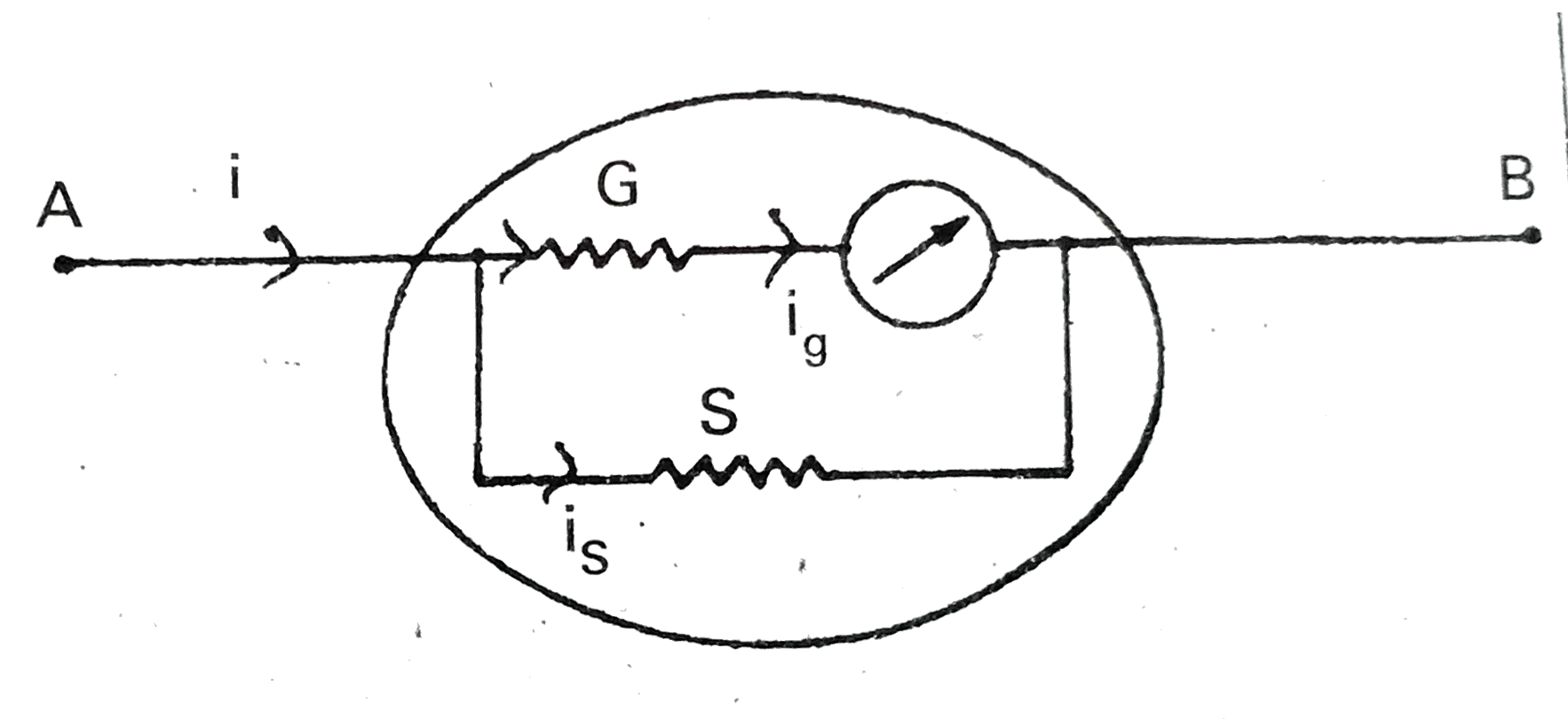How can a galvanometer be converted to an ammeter ? Why is the parallel resistance smaller that the galvanometer resistance ? A moving coil galvanometer can measure a current of 10−6 A. What is the resistance of the shunt required if it is to measure 1A ?Solution in Telugu
Conversion of Galvanometer into Ammeter : Galvanometer is converted into an ammeter by connecting a suitable resistance is parallel to it. This arrangement decreases the effective resistance. Ammeter is used for measuring the current in an electric circuit and it is connected in series in circuit. The inclusion of the ammeter in the circuit should not alter the current or total resistance of the circuit so it has very low resistance.
The resistance of An ideal Ammeter is zero.
let G and S be the Galvanometer and shunt resistances respectively.
Let 'i' be the total current, divided at A into igandis as shown in fig. From Kirchhoff's Ist law i=ig+is
As 'G' and 'S' are parallel P.D. across Galvanometer = P.D. across shunt
igG=isS
S=igisG
=Gigi−ig [∵is=i−ig]
S=Giig−1
If iig=n⇒ig=in
∴ The current flowing through the galvanometer be (1n)h of tatal current.
∴S=Gn−1
If 'R' is the effective resistance between points 'A' and 'B' then
1R=1G+1S=S+GGS
R=GSS+G
iR=isS⇒is=iSR=iS(GSS+G)=(GS+G)i
is=(GS+G)i
Similarly iR=igG⇒ig=iGR=iG[GSS+G]=(SS+G)i
ig=(SS+G)i
Hence current through galvanometer is proportinal is proportional to the total current. Since 'S' is small major portion of the current flows through it and a small portion of current flows through G. So shunt protects the galvanometer from high currents. Parallel resistance is smaller than Galvanometer resistance because to protect the Galvanometer from high (large) current (or) to pass. Large currents through shunt and small current passes through the galvanometer.

Solution for the problem : Current in the circuit, i=1A,
Current through the galvanometer, ig=10−6A
Shunt resistance, S=Gn−l=Giig−l=Gl06−l=G99.999Ω
Topper's Solved these Questions
- BOOK - VIKRAM PUBLICATION ( ANDHRA PUBLICATION)CHAPTER - MOVING CHARGES AND MAGNETISHMEXERCISE - TEXTUAL EXERCISES14videos
MOVING CHARGES AND MAGNETISHM
- BOOK - VIKRAM PUBLICATION ( ANDHRA PUBLICATION)CHAPTER - MOVING CHARGES AND MAGNETISHMEXERCISE - ADDITIONAL EXERCISES26videos
MOVING CHARGES AND MAGNETISHM
- BOOK - VIKRAM PUBLICATION ( ANDHRA PUBLICATION)CHAPTER - MOVING CHARGES AND MAGNETISHMEXERCISE - LONG ANSWER QUESTIONS5videos
MOVING CHARGES AND MAGNETISHM
- BOOK - VIKRAM PUBLICATION ( ANDHRA PUBLICATION)CHAPTER - MAGNETISM AND MATTEREXERCISE - Additional Exercises19videos
MAGNETISM AND MATTER
- BOOK - VIKRAM PUBLICATION ( ANDHRA PUBLICATION)CHAPTER - NUCLEIEXERCISE - DAM SURE (VSAQ)1videos
NUCLEI
Similar Questions
A circular coil of wire consisting of 100 turns, each of radius 8.0 cm carries a current of 0.40 A. What is the magnitude of the magnetic field B at the centre of the coil ?
02:15View SolutionTwo concentric circular coils X and Y of radii 16 cm and 10 cm, respectively, lie in the same vertical plane containing the north to south direction. Coil X has 20 turns and carries a current of 16 A, coil Y has 25 turns and carries a current of 18 A. The sense of the current in X is anticlockwise, and clockwise in Y, for an observer looking at the coils facing west. Give the magnitude and direction of the net magnetic field due to the coils at their centre.
01:26View SolutionDeduce an expression for the force on a current carrying conductor placed in a magnetic field. Derive an expression for the force per unit length between two parallel current. Carrying conductors.
02:19View SolutionWhy does a paramagnetic sample display greater magnetisation (for the same magnetising field) when cooled?
06:14View SolutionThe half life of .58Co is 72 days. Calculate its average life.
02:49View SolutionThe resistance of a moving coil galvanometer is 5 ohm . The maximum current it can measure is 0.015A . To convert it into an ammeter to measure 1.5A
02:20View SolutionIf the galvanometer current is 10 mA, resistance of the galvanometer is 40Ω and shunt of 2Ω is connected to the galvanometer, the maximum current which can be measured by this ammeter is
02:12View SolutionA moving coil galvanometer can measure a current of 10^(-6) A. What is the resistance of the shunt required if it is to measure 1A ?
02:10View SolutionHow can galvanometer be converted to a voltmeter ? Why is the series resistance greater that the galvanometer resistance ? A moving coil galvanometer of resistance 5Omega can measure a current of 15mA. What is the series resistance required if it is to measure 1.5 V ?
01:35View SolutionAn ammeter consists of a galvanometer of a resistance 45 Omega shunted with a resistance of 3 Omega . If the current rating of that can be measured by the ammeter will be
03:59View SolutionIn an ammeter, 10% of the main current is passing through galvanometer, it the galvanometer is shunted with a 10 Omega resistance. What is the resistance of the galvanometer ?
04:23View SolutionWhat is the value of shunt resistance required to convert a galvanometer of resistance 100Ω into an ammeter of range 1A ? (Given : Full scale deflection of the galvanometer is 5 mA.)
01:57View SolutionA galvanometer of resistance 50Ω is converted into an ammeter by connecting a low resistance (shunt) of value 1Ω in parallel to the galvanometer, S. If full - scale deflection current of the galvanometer is 10 mA, then the maximum current that can be measured by the ammeter is -
View Solutionयदि एक गैल्वेनोमीटर का प्रतिरोध 6Ω हो और यह 2 A की अधिकतम धारा माप सकता है, तो इसे 6 A तक की धारा मापने वाले ऐमीटर में बदलने के लिए आवश्यक शंट प्रतिरोध है
01:58View SolutionIn the circuit the current is to be measured. What is the value of the current if the ammeter shown (a) is a galvanometer with a resistance RG=60.00Ω, (b) is a galvanometer described in (a) but converted to an ammeter by a shunt resistance rs=0.02Ω, (c ) is an ideal ammeter with zero resistance?
 02:30View Solution
02:30View Solution

